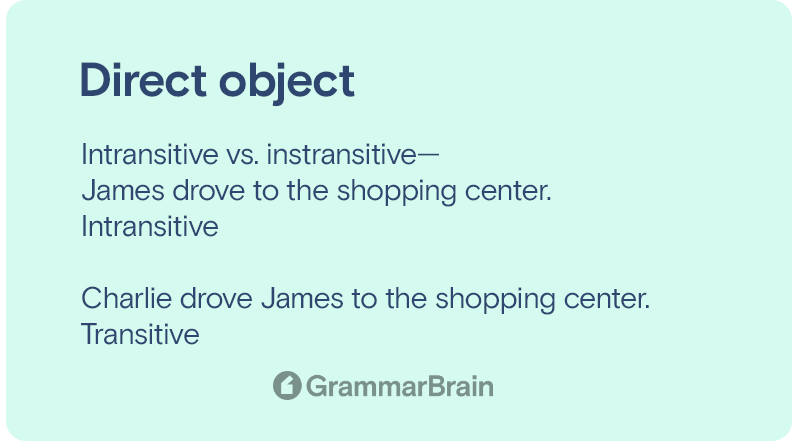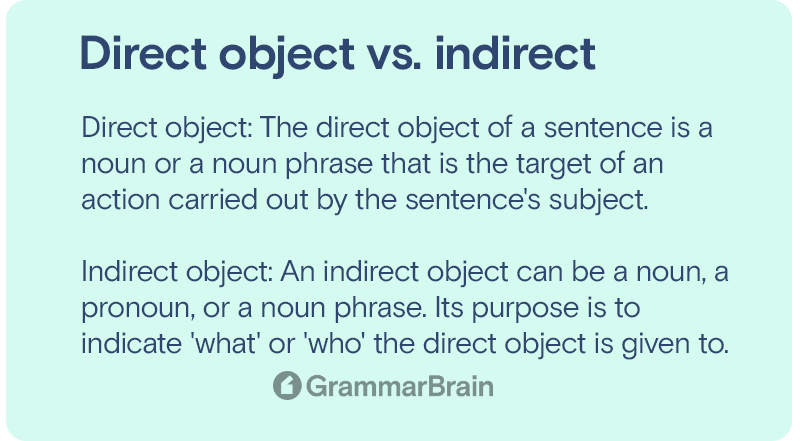What is a direct object? How does a direct object work? A word or phrase that is the recipient of the action of the verb is referred to as the direct object in English grammar.
Understanding direct object with the help of an example
Take the following instance, as a way to better grasp what this means:
- James plays football.
Football is the item that the immediate object of this phrase is. Football is the subject of the activity, while the term plays serves as the verb in this sentence.

What is the definition of a “direct object”?
A noun that is the recipient of the action of the verb is referred to as the “direct object.”
It’s possible to confuse the direct object with the topic of the statement. However, it can be avoided with a sufficient understanding of the topic (in the sentence).
There’s also the potential that you’re mixing the direct object and the questionable verb.
It’s critical to keep in mind that the subject is the noun that is responsible for carrying out the activities.
In most cases, direct objects provide responses to the questions like “what?” or “whom?”
Let’s take a second look at the example of the direct object that was given before.
- James plays football.
Consider this: “What game did James play?
The correct response is the immediate object of the question, which in this instance is “football.”
Let’s look at another example of a direct object:
- Charles played with his dog.
What does “direct object” refer to? Pose the question to yourself, “Who was Charles’s playmate? ” The correct response is “dog,” of course.

The difference between transitive and intransitive verbs
Not all verbs employ a direct object. It’s impossible to utilize direct objects with some verbs, such as ‘laugh’ and ‘sit’ since doing so would be illogical.
You cannot laugh at something or seat someone; doing so would be meaningless.
Verbs that require a direct object are known as transitive verbs, whereas verbs that do not require an object are known as intransitive verbs.
Sometimes intransitive verbs are preceded by a prepositional phrase or an adverbial phrase, which are not the same as direct objects.
This makes it difficult to determine the difference between the two types of verbs.
- James and Charlie laugh at Julie.
It may appear that Julie is the direct object in this sentence. However, the presence of the preposition ‘at’ reveals that the phrase in question is actually a prepositional phrase.
It’s not proper to say, “James and Charlie laugh Julie” since laugh is an intransitive verb. It might help to who we’re laughing at by using a prepositional phrase.
On the other hand, it’s accurate to claim, “James and Charlie enjoy Julie.”
Because the word ‘enjoy’ is transitive in this context, a preposition is not required when Julie becomes the direct object of the verb.
Sometimes, depending on the context, the same word might function either transitively or intransitively.
If a verb may have more than one meaning, then some of the uses of the verb could be transitive, while other uses could be intransitive.
Examples:
- James drove to the shopping center. – Intransitive
- Charlie drove James to the shopping center. – Transitive
The simplest approach for determining whether a verb is transitive or intransitive is to consult a dictionary. However, the best method to distinguish between the two is by experience.
When you’re in a jam, the question “what?” or “whom?” might be really helpful.
If you receive a response, the expression is considered transitive. And if there is no answer, presume that it’s an intransitive verb.
This is especially helpful for terms like ‘play’ that may be used either transitively or intransitively depending on the context.
Expressions and clauses with direct objects
Sometimes, rather than being a single word, direct objects are full phrases or even whole clauses. This is not always the case.
These phrases are always functioning together as nouns; hence, in addition to being normal noun phrases, they are frequently gerund phrases or relative clauses.
Note:
- Relative clauses are clauses that begin with a relative pronoun like “what,” as opposed to independent clauses, which begin with a noun.
- Noun phrases that begin with gerunds are referred to as gerund phrases.
The infinitive form of a verb can occasionally be used as a direct object.
Pronouns that take direct objects
In English, the same person can be referred to by two different pronouns, depending on whether the pronoun is operating as a subject or an object.
For instance, the pronoun “I” would be used when discussing yourself as the subject of a sentence.
However, if you were describing oneself as the subject of the phrase, “myself” would be used.

What exactly is the distinction between a direct object and an indirect object?
It’s possible to significantly enhance the readability of your whole sentences by being familiar with direct objects, indirect objects, and both types of objects.
First, let’s get a handle on the difference between direct and indirect objects.
The object of direct object
The direct object of a sentence is a noun or a noun phrase that is the target of an action carried out by the sentence’s subject.
The beneficiary of the action of a transitive verb is referred to as the “what” or the “whom” of the phrase, which is a direct object.
It’s the part of the phrase that is doing the receiving of the action. On the other hand, unlike sentences with connecting verbs, sentences that do not have an indirect object are not required to have one.
The object of indirect object
An indirect object can be a noun, a pronoun, or a noun phrase. Its purpose is to indicate ‘what’ or ‘who’ the direct object is given to.
The direct object gives something to the indirect object, therefore an indirect object may only exist in a sentence if there is also a direct object present in the sentence.
What exactly differentiates the two from one another?
It’s easy to get direct and indirect objects mixed up, but there are a few important distinctions that make it simpler to spot the difference between the two.
1. The connection between them and the event
In a sentence, direct objects are the ones that are affected by the action of a verb, whereas indirect objects are the ones that are affected by the direct object.
2. Their application
In order for a sentence to be considered “full,” a transitive verb in the English language has to have a direct object.
On the other hand, indirect objects are only ever used with intransitive verbs and are frequently introduced by prepositions.
3. The significance of them
In order for many sentences to be considered complete, direct objects will be required; nevertheless, an indirect object is not required for every statement.
Direct objects, on the other hand, are able to exist even in the absence of indirect objects, whereas indirect objects are required for the existence of indirect things.
What are some of the parallels that can be seen between direct and indirect objects?
Both direct and indirect objects can be composed of nouns, noun phrases, or pronouns. It’s the primary characteristic that links the two categories of things together.
Whether the word in question functions as a direct object or an indirect object is determined by the target of the action being performed by the subject.
Techniques for working with direct objects
In order to make appropriate use of direct objects, the following are a few pointers to keep in mind.
1. Always coming after the action verb is the direct object.
Finding the transitive verb in the sentence is a simple approach to finding out where your direct object should belong in English grammar.
The transitive verb is a verb that acts in connection to one or more objects. A transitive or action verb should be followed by a direct object.
2. Ensure the direct object is a noun, pronoun, or clause.
There are three possible forms for a direct object: a noun, a pronoun, or a noun phrase. Different elements of speech, such as verbs, adverbs, and adjectives, cannot take the place of direct objects in a sentence.
3. Make use of several examples.
When the context calls for it, include many direct objects in a single statement.
4. Keep an eye out for connecting verbs.
Direct objects are not allowed in sentences that contain linking verbs (such as, is, or were).
Tip: Learn about direct object pronouns. A direct object pronoun can get confused with a regular direct object.
FAQs
1. What are some examples of direct objects?
The noun, noun phrase, or pronoun that is the recipient of the action of the verb is referred to as the direct object.
2. What does it look like when a direct object is used?
Here is an example of a direct object – James watches an old movie.
3. What are some direct object examples?
The construction of a sentence with a direct object is: Subject + Verb + Who or What
Examples would be, “Sam enjoyed lemonade and a steak for dinner.”
4. Do direct objects follow transitive verbs?
Yes, transitive verbs typically follow direct objects in a sentence or question sentence. The transitive verb is required to create a complete sentence. Direct objects receive the action of a transitive verb.
5. Do linking verbs help direct objects?
Linking verbs use direct objects, although the word that follows the linking verb is actually called a complement (or subject complements).
Sources
- Direct Objects in English (with Examples)
- What Is a Direct Object? (with Examples)
- Direct Object
- Direct Object Examples
- Direct Object: Definition and Examples
- Difference Between Direct and Indirect Objects in a Sentence
Inside this article
Fact checked:
Content is rigorously reviewed by a team of qualified and experienced fact checkers. Fact checkers review articles for factual accuracy, relevance, and timeliness. Learn more.
Core lessons
Glossary
- Abstract Noun
- Accusative Case
- Anecdote
- Antonym
- Active Sentence
- Adverb
- Adjective
- Allegory
- Alliteration
- Adjective Clause
- Adjective Phrase
- Ampersand
- Anastrophe
- Adverbial Clause
- Appositive Phrase
- Clause
- Compound Adjective
- Complex Sentence
- Compound Words
- Compound Predicate
- Common Noun
- Comparative Adjective
- Comparative and Superlative
- Compound Noun
- Compound Subject
- Compound Sentence
- Copular Verb
- Collective Noun
- Colloquialism
- Conciseness
- Consonance
- Conditional
- Concrete Noun
- Conjunction
- Conjugation
- Conditional Sentence
- Comma Splice
- Correlative Conjunction
- Coordinating Conjunction
- Coordinate Adjective
- Cumulative Adjective
- Dative Case
- Determiner
- Declarative Sentence
- Declarative Statement
- Direct Object Pronoun
- Direct Object
- Diction
- Diphthong
- Dangling Modifier
- Demonstrative Pronoun
- Demonstrative Adjective
- Direct Characterization
- Definite Article
- Doublespeak
- False Dilemma Fallacy
- Future Perfect Progressive
- Future Simple
- Future Perfect Continuous
- Future Perfect
- First Conditional
- Irregular Adjective
- Irregular Verb
- Imperative Sentence
- Indefinite Article
- Intransitive Verb
- Introductory Phrase
- Indefinite Pronoun
- Indirect Characterization
- Interrogative Sentence
- Intensive Pronoun
- Inanimate Object
- Indefinite Tense
- Infinitive Phrase
- Interjection
- Intensifier
- Infinitive
- Indicative Mood
- Participle
- Parallelism
- Prepositional Phrase
- Past Simple Tense
- Past Continuous Tense
- Past Perfect Tense
- Past Progressive Tense
- Present Simple Tense
- Present Perfect Tense
- Personal Pronoun
- Personification
- Persuasive Writing
- Parallel Structure
- Phrasal Verb
- Predicate Adjective
- Predicate Nominative
- Phonetic Language
- Plural Noun
- Punctuation
- Punctuation Marks
- Preposition
- Preposition of Place
- Parts of Speech
- Possessive Adjective
- Possessive Determiner
- Possessive Case
- Possessive Noun
- Proper Adjective
- Proper Noun
- Present Participle
- Prefix
- Predicate



